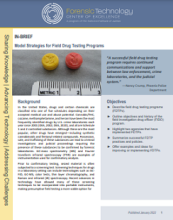Drug testing
Drug Testing in a Drug Court Environment: Common Issues To Address
Model Strategies for Field Drug Testing Programs
The problems with Cannabinoid Analogs (Delta-8 THC, Delta-10 THC and CBD) and their metabolites detectability in urine drug testing for potential cannabinoid abuse.
FIELDABLE MASS SPECTROMETRY FOR FORENSIC SCIENCE, HOMELAND SECURITY, AND DEFENSE APPLICATIONS
Economic Evaluation of the HOPE Demonstration Field Experiment
NIJ Recidivism Forecasting Challenge Webinar Transcript
Challenge has closed
Thank you to everyone who submitted an entry. Winners will be notified by August 16, 2021, and posted online.
Winners are to submit paper outlining the variables that were tested, indicating which were of statistical significance and which were not, by September 17, 2021.
DARYL FOX: Good afternoon, everyone. Welcome to today's webinar. NIJ's Recidivism Forecasting Challenge, hosted...
Fast and Portable Drug Testing: Dual-Method Prototype Shows Promise for Court-Admissible Drug Testing
Research on Forensic Toxicological Laboratory Testing and Reporting Practices
Research on Forensic Toxicological Laboratory Testing and Reporting Practices
Expanding Research to Examine the Impacts of Forensic Science on the Criminal Justice System
In 2004, the National Institute of Justice created the social science research on forensic sciences (SSRFS) research program to explore the impact of forensic sciences on the criminal justice system and the administration of justice. Much of the early research from the SSRFS program focused on DNA processing and the use of DNA in investigations and prosecutions.
See the YouTube Terms of Service and Google Privacy Policy




